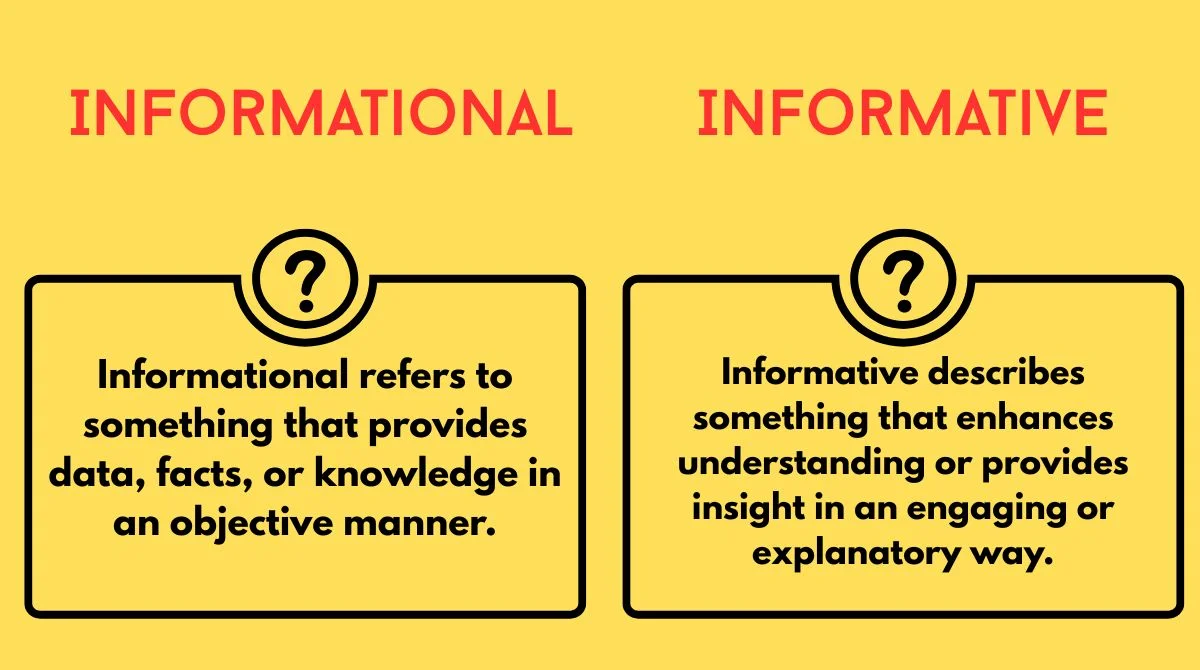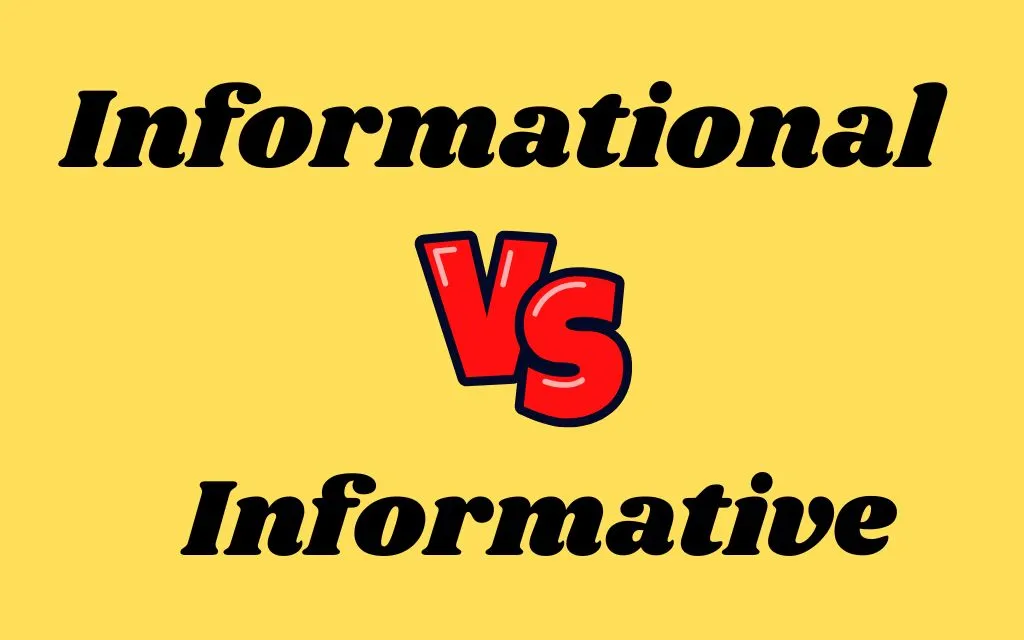Last updated on September 14th, 2025 at 11:48 am
Language can be tricky, especially when two words seem almost identical. Informational and informative are often used interchangeably, but they serve different functions. While both relate to knowledge and learning, their meanings, usage, and contexts differ.
This article will break down the distinctions between informational and informative, explore their applications in writing, education, and social media, and provide real-world examples to help you understand when to use each term correctly.
Is something informational or informative? “Informational” refers to presenting facts and data objectively, while “informative” enhances understanding with explanations and insights. Learn the key differences here!

Understanding the Basics: Informational vs. Informative Texts
At first glance, informational and informative may seem like synonyms, but there are subtle differences in how they function.
- Informational refers to something that provides data, facts, or knowledge in an objective manner.
- Informative describes something that enhances understanding or provides insight in an engaging or explanatory way.
Quick Comparison Table
| Aspect | Informational | Informative |
|---|---|---|
| Definition | Provides factual data, raw information | Provides knowledge with added clarity, depth, or analysis |
| Purpose | To present details in a structured way | To educate, explain, or enhance understanding |
| Examples | Research reports, data sheets, instruction manuals | Blog posts, documentaries, news articles |
| Tone | Neutral, objective, data-driven | Engaging, explanatory, educational |
Understanding these differences is key when choosing the right term in your writing.
Characterizing Informational Text
Informational text is designed to present facts, statistics, and details without personal opinion or subjective analysis. It is often structured logically and follows a clear format to make data easily accessible.
Features of Informational Text:
- Objective Tone: Lacks opinion, emotion, or persuasion.
- Fact-Based Content: Includes verified facts, figures, and statistics.
- Clear Structure: Often formatted with headings, bullet points, and lists for easy comprehension.
- Technical or Formal Language: Uses precise terminology suited to the subject matter.
Examples of Informational Text:
- Encyclopedias
- Government reports
- Scientific studies
- Instruction manuals
These texts exist purely to inform rather than to engage or persuade.
The Purpose and Style of Informative Writing
Informative writing, on the other hand, aims to present information in a way that enhances understanding and makes the content more engaging. Unlike informational text, informative writing often includes explanations, examples, and interpretations to help the reader grasp the subject.
Characteristics of Informative Writing:
- Clarity and Engagement: Focuses on making complex information digestible.
- Educational Purpose: Helps readers understand a topic rather than just listing facts.
- Explanatory Tone: Uses analogies, case studies, and examples to clarify concepts.
- More Accessible Language: Written for general audiences, often avoiding technical jargon.
Examples of Informative Writing:
- Blog posts
- Explainer articles
- Documentaries
- How-to guides
While both informational and informative texts provide knowledge, informative writing is crafted to be more engaging and educational.
Types of Informative Texts: Exploring the Variety
Informative content appears in many forms, each designed to serve a specific audience. Here are some common types:
- Expository Essays – Provide explanations on a topic without personal opinions.
- News Articles – Present facts while also adding context and background information.
- How-to Guides & Tutorials – Teach readers how to perform a task step by step.
- Scientific and Educational Articles – Explain findings in a way that makes them understandable.
- FAQs (Frequently Asked Questions) – Provide detailed answers to common queries.
Each of these forms aims to educate and engage, making learning more effective.
Utilizing Visual Aids: Graphics and Illustrations in Informational Content
Informational texts often include visual aids to enhance comprehension. Because these texts prioritize factual accuracy and clarity, adding charts, diagrams, and graphs helps to:
- Present complex data in a digestible format
- Highlight trends and relationships
- Improve retention of information
Examples of Visual Aids in Informational Content:
| Type of Visual | Purpose | Example Usage |
|---|---|---|
| Graphs | Show numerical data trends | Population growth trends |
| Charts | Compare and organize information | Product feature comparison |
| Diagrams | Explain processes visually | Human anatomy diagram |
| Tables | Provide structured data | Monthly expense breakdown |
In technical, academic, and research-based content, visual aids are essential tools for simplifying information.
Visual Aids in Education: The Path to Better Learning
Visuals play a crucial role in educational content, whether it is informational or informative. Studies show that people retain information 65% better when it’s paired with images, compared to just text alone.
Benefits of Using Visuals in Learning:
- Increases Retention: Visual memory is stronger than text-based memory.
- Enhances Understanding: Complex ideas become more accessible.
- Engages Learners: Keeps readers interested and focused.
For example, infographics in informative articles make content easier to understand by combining facts with engaging design elements.
Real-World Examples of Informative Content on Social Media Platforms
Social media is full of informative content, ranging from educational videos to explainer posts. Here’s how platforms use it effectively:
- YouTube: Educational channels like TED-Ed provide engaging informative content.
- Instagram & TikTok: Short-form videos breaking down science, finance, and language topics.
- LinkedIn Articles: Professionals share industry insights and career tips.
These platforms show that informative content isn’t limited to books and blogs—it thrives in digital spaces, too.
Keywords and Intent: Tailoring Content for Information-Seeking Audiences
In SEO (Search Engine Optimization), understanding search intent is crucial when choosing between informational and informative content.
| Keyword Type | Search Intent | Example Searches |
|---|---|---|
| Informational | Users want raw data or factual content | “List of U.S. presidents” |
| Informative | Users seek detailed explanations | “What is the difference between effect and affect?” |
When creating content, knowing the intent behind keywords helps tailor it to what the audience is looking for.\

FAQs
1. What does “informational” mean?
“Informational” describes content that presents raw facts and data without opinions or analysis. Examples include research reports, instruction manuals, and encyclopedias.
2. What does “informative” mean?
“Informative” refers to content that enhances understanding by explaining, analyzing, or engaging the audience. Examples include blog posts, documentaries, and how-to guides.
3. Can “informational” and “informative” be used interchangeably?
Not always. Informational content provides data objectively, while informative content explains and educates the reader. For example, a research paper is informational, but a TED Talk is informative.
4. How do businesses use informational and informative content?
- Informational content: Data sheets, reports, and policies to provide essential details.
- Informative content: Blog posts, tutorials, and explainer videos to educate and engage customers.
5. What type of content benefits from visual aids?
Both informational and informative content benefit from visuals like charts, graphs, infographics, and diagrams. These tools make data easier to understand and retain.
6. How do search engines treat informational vs. informative content?
- Informational searches look for raw data (e.g., “list of U.S. presidents”).
- Informative searches seek explanations (e.g., “difference between effect and affect”).
Optimizing content based on search intent improves SEO and ranking.
Conclusion
While informational and informative both relate to knowledge and learning, their uses differ significantly.
- Informational texts provide raw facts and objective data.
- Informative writing enhances understanding through explanations and engagement.
Whether you’re writing a research report, crafting a blog post, or creating educational materials, choosing the right term can make all the difference in clarity and accuracy.
Which type of content do you use most often? Let us know in the comments!
